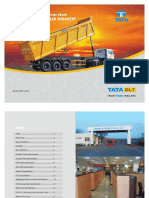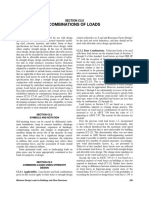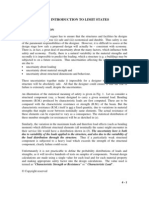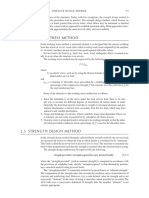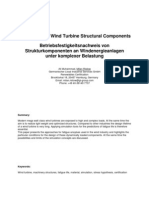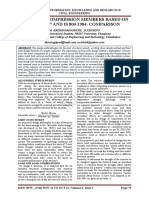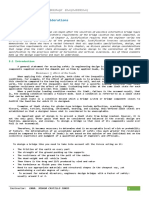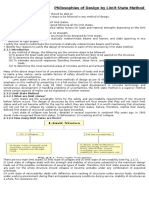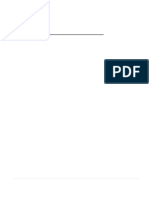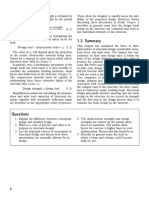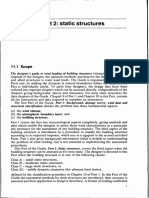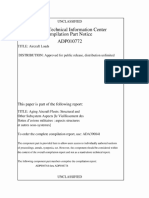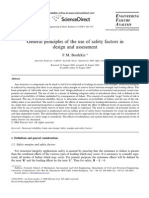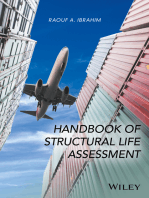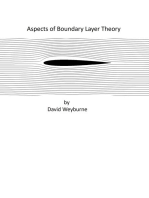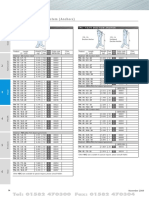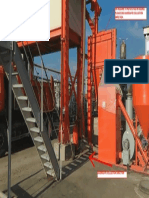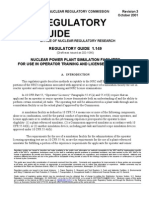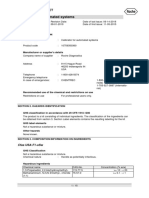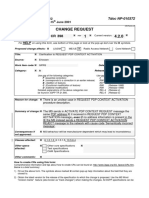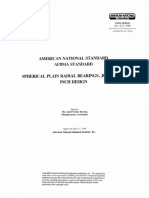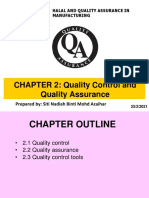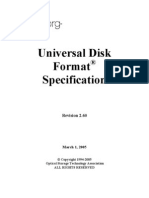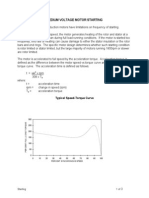PDF Compression, Ocr, Web-Optimization With Cvision'S Pdfcompressor
PDF Compression, Ocr, Web-Optimization With Cvision'S Pdfcompressor
Uploaded by
KhaleelCopyright:
Available Formats
PDF Compression, Ocr, Web-Optimization With Cvision'S Pdfcompressor
PDF Compression, Ocr, Web-Optimization With Cvision'S Pdfcompressor
Uploaded by
KhaleelOriginal Title
Copyright
Available Formats
Share this document
Did you find this document useful?
Is this content inappropriate?
Copyright:
Available Formats
PDF Compression, Ocr, Web-Optimization With Cvision'S Pdfcompressor
PDF Compression, Ocr, Web-Optimization With Cvision'S Pdfcompressor
Uploaded by
KhaleelCopyright:
Available Formats
8 Safety factors, loads and pressures
To ensure acceptable compliance with these limit-states, their design by methods based on permissible working
various partial factors of safety are employed in limit-state stresses.
design. The particular values selected for these factors
depend on the accuracy known for the load or strength to Note When carrying out any calculation, it is most
which the factor is being applied, the seriousness of the important that the designer is absolutely clear as to the
consequences that might follow if excessive loading or stress condition he is investigating. This is of especial importance
occurs, and so on. Some details of the various partial factors when he is using values obtained from tables or graphs such
of safety specified in BS8I 10 and CPI 10 and their applica- as those given in Part II of this book. For example, tabulated
tion are set out in Table I and discussed in Chapter 8. It values for the strength of a section at the ultimate limit-state
will be seen that at each limit-state considered, two partial must never be used to satisfy the requirements obtained by
safety factors are involved. The characteristic loads are carrying out a serviceability analysis, i.e. by calculating
multiplied by a partial safety factor for loads Yf to obtain bending moments and shearing forces due to unfactored
the design loads, thus enabling calculation of the bending characteristic loads.
moments and shearing forces for which the member is to
be designed. Thus if the characteristic loads are multiplied
2.2 CHARACTERISTIC LOADS
by the value of y1 corresponding to the ultimate limit-state,
the moments and forces subsequently determined will re- The loads acting on a structure are permanent (or dead)
present those occurring at failure, and the sections must be loads and transient (or imposed or live) loads. As explained
designed accordingly. Similarly, if the value of y1 corres- above, a design load is calculated by multiplying the
ponding to the limit-state of serviceability is used, the characteristic load by the appropriate partial factor of safety
moments and forces under service loads will be obtained. for loads According to the Code Handbook a character-
In a similar manner, characteristic strengths of materials istic load is, by definition, 'that value of load which has an
used are divided by a partial safety factor for materials accepted probability of its not being exceeded during the
Ym to obtain appropriate design strengths for each life of the structure' and ideally should be evaluated from
material. the mean load with a standard deviation from this value.
Although serviceability limit-state calculations to ensure BS8I 10 states that for design purposes the loads set out in
the avoidance of excessive cracking or deflection may be BS6399: Part 1and CP3: Chapter V: Part 2 may be
undertaken, and suitable procedures are outlined to under- considered as characteristic dead, imposed and wind loads.
take such a full analysis for every section would be too Thus the values given in Tables 2—8 may be considered
time-consuming and arduous, as well as being to be characteristic loads for the purposes of limit-state
Therefore BS8 110 and CPI 10 specify certain limits relating calculations.
to bar spacing, slenderness etc. and, if these criteria are In the case of wind loading, in CP3: Chapter V: Part 2 a
not exceeded, more-detailed calculations are unnecessary. multiplying factor S3 has been incorporated in the express-
Should a proposed design fall outside these tabulated ion used to determine the characteristic wind load to
limiting values, however, the engineer may still be able to take account of the probability of the basic wind speed being
show that his design meets the Code requirements regarding exceeded during the life of the structure.
serviceability by producing detailed calculations to validate
his claim.
2.3 DEAD LOADS
Apart from the partial factor of safety for dead +
imposed + wind load, all the partial safety factors relating Dead loads include the weights of the structure itself and
to the serviceability limit-state are equal to unity. Thus the any permanent fixtures, partitions, finishes, superstructures
calculation of bending moments and shearing forces by using and so on. Data for calculating dead loads are given in
unfactored dead and imposed loads, as is undertaken with Tables 2,3 and 4: reference should also be made to the notes
modular-ratio and load-factor design, may conveniently be relating to dead loads given in section 9.1.
thought of as an analysis under service loading, using
limiting permissible service stresses that have been determin-
ed by applying overall safety factors to the material strengths. 2.4 IMPOSED LOADS
Although imprecise, this concept may be useful in appreciat- Imposed (or transient or live) loads include any external
ing the relationship between limit-state and other design loads imposed upon the structure when it is serving its
methods, especially as permissible-working-stress design is normal purpose, and include the weight of stored materials,
likely to continue to be used for certain types of structures furniture and movable equipment, cranes, vehicles, snow,
and structural members (e.g. chimneys) for some time to wind and people. The accurate assessment of the actual and
come, especially where the behaviour under service loading probable loads is an important factor in the production of
is the determining factor. In view of the continuing usefulness economical and efficient structures. Some imposed loads,
of permissible-working-stress design, which has been shown such as the pressures and weights due to contained liquids,
by the experience of many years to result in the production can be determined exactly; less definite, but capable of being
of safe and economical designs for widely diverse types of calculated with reasonable accuracy, are the pressures of
structure, most of the design data given elsewhere in this retained granular materials. Other loads, such as those on
book, particularly in those chapters dealing with structures floors, roofs and bridges, are generally specified at character-
other than building frames and similar components, are istic values. Wind forces are much less definite, and marine
related to the analysis of structures Lnder service loads and forces are among the least determinable.
PDF compression, OCR, web-optimization with CVISION's PdfCompressor
You might also like
- Brochure TATA TrailerDocument20 pagesBrochure TATA TrailerRam RK100% (1)
- Reinforced Concrete Buildings: Behavior and DesignFrom EverandReinforced Concrete Buildings: Behavior and DesignRating: 5 out of 5 stars5/5 (1)
- Aircraft Weight and Balance Handbook: FAA-H-8083-1AFrom EverandAircraft Weight and Balance Handbook: FAA-H-8083-1ARating: 5 out of 5 stars5/5 (1)
- PF17415Document222 pagesPF17415eduardo chavezNo ratings yet
- Load ComboDocument7 pagesLoad ComboAnonymous ya6gBBwHJFNo ratings yet
- Design Procedure For Steel Frame Structures According TO BS 5950Document46 pagesDesign Procedure For Steel Frame Structures According TO BS 5950Uvie M. PtwolanNo ratings yet
- Design of Steel Frames - BS 5950Document46 pagesDesign of Steel Frames - BS 5950Rashy PR100% (1)
- Combinations of LoadsDocument6 pagesCombinations of Loadsivan bolañosNo ratings yet
- Design Procedure For Steel Frame Structures According To Bs 5950Document46 pagesDesign Procedure For Steel Frame Structures According To Bs 5950Chong Chee Yen100% (2)
- Design Procedure For Steel Frame Structures According To Bs 5950Document46 pagesDesign Procedure For Steel Frame Structures According To Bs 5950Ali Gaffar100% (2)
- Casing Design FactorsDocument2 pagesCasing Design FactorsYougchu Luan100% (1)
- Chapter 4Document9 pagesChapter 4Mohamed ZaglolNo ratings yet
- Marine Structural Design-26-30Document5 pagesMarine Structural Design-26-30Mohamed AttiaNo ratings yet
- Limit State DesignDocument12 pagesLimit State DesignEzhil KumarNo ratings yet
- Partial Safety Factor On Material and Load Based On IS456, Eurocode &ACIDocument8 pagesPartial Safety Factor On Material and Load Based On IS456, Eurocode &ACISudip ShresthaNo ratings yet
- Al Nageim - Chapter 2Document18 pagesAl Nageim - Chapter 2Ram Aravind100% (1)
- Lecture Notes Stab 2 Class 5&6Document8 pagesLecture Notes Stab 2 Class 5&6Bhavanen RungapenNo ratings yet
- Untitled Extract Pages 6Document1 pageUntitled Extract Pages 6Fakhere AlamNo ratings yet
- Chapter 9 - Strength and Serviceability Requirements: CommentaryDocument3 pagesChapter 9 - Strength and Serviceability Requirements: CommentarywaheedamerNo ratings yet
- Fatigue Life of Wind Turbine Structural ComponentsDocument7 pagesFatigue Life of Wind Turbine Structural ComponentsRajamani ThiruvengadamNo ratings yet
- Design of Compression Members Based On IS 800-2007 AND IS 800-1984-COMPARISONDocument5 pagesDesign of Compression Members Based On IS 800-2007 AND IS 800-1984-COMPARISONakshay kothiyalNo ratings yet
- Advance Reinforced Concrete Design To BS 8110-1:1997: F. M. M AbdullahDocument12 pagesAdvance Reinforced Concrete Design To BS 8110-1:1997: F. M. M AbdullahMohamed AbdNo ratings yet
- Factor of Safety (F.S.)Document42 pagesFactor of Safety (F.S.)IsmailNo ratings yet
- Aashto Load FactorsDocument20 pagesAashto Load FactorsRaihan MomandNo ratings yet
- General Design Considerations: Bridge EngineeringDocument11 pagesGeneral Design Considerations: Bridge EngineeringEna Mie CambaNo ratings yet
- Studi Perbandingan Metoda WSD Dan LRFD Dalam Anali PDFDocument15 pagesStudi Perbandingan Metoda WSD Dan LRFD Dalam Anali PDFAldy JuraisNo ratings yet
- Sec9 - 1 Required DTADocument3 pagesSec9 - 1 Required DTARickNo ratings yet
- Philosophies of Design by Limit State Method: Instructional ObjectivesDocument6 pagesPhilosophies of Design by Limit State Method: Instructional ObjectiveshghjjjkNo ratings yet
- Chapter 3 PDFDocument8 pagesChapter 3 PDFShazreel AmirNo ratings yet
- En 015 09Document20 pagesEn 015 09HemanthKumarNo ratings yet
- BS5950 Load CasesDocument46 pagesBS5950 Load CasesthespecifierNo ratings yet
- Chapter17 SeismicResistantDesignDocument54 pagesChapter17 SeismicResistantDesignaasimNo ratings yet
- Flexural Member 2012-2013Document76 pagesFlexural Member 2012-2013saztaNo ratings yet
- 400 Level - Structures - Day2Document8 pages400 Level - Structures - Day2Ismail Mubarak olaNo ratings yet
- Comparative Study of Steel Structures Design Using IS 800 PDFDocument8 pagesComparative Study of Steel Structures Design Using IS 800 PDFshivarajNo ratings yet
- Loads and Load Combinations: Steel DesignDocument12 pagesLoads and Load Combinations: Steel DesignArkarNo ratings yet
- 02 Design Loads SummaryDocument20 pages02 Design Loads SummaryEliminator JandiruNo ratings yet
- Prof. Kame G. S. Lsmrcs Lecture Notes Civil Engg. Dept. Datta Meghe Coemumbai Uni Limit State Method of Reinforced Concrete Design Confirming To I S 456 2000 AssumptionsDocument4 pagesProf. Kame G. S. Lsmrcs Lecture Notes Civil Engg. Dept. Datta Meghe Coemumbai Uni Limit State Method of Reinforced Concrete Design Confirming To I S 456 2000 Assumptionsconfig_strNo ratings yet
- Lecture On Limit State Design by Manish BhutaniDocument27 pagesLecture On Limit State Design by Manish BhutaniTarunNo ratings yet
- Designer's Guide To Wind Loading of Building Structures. Part 2-Static Structures. Chapter 11 - About Part 2 - Static Structures. (2 of 12)Document7 pagesDesigner's Guide To Wind Loading of Building Structures. Part 2-Static Structures. Chapter 11 - About Part 2 - Static Structures. (2 of 12)ferdinand bataraNo ratings yet
- Numerical Evaluation of Damage Distribution Over A Slat Track Using Flight Test DataDocument9 pagesNumerical Evaluation of Damage Distribution Over A Slat Track Using Flight Test Datareek_bhatNo ratings yet
- Defense Technical Information Center Compilation Part NoticeDocument20 pagesDefense Technical Information Center Compilation Part NoticeBala KrishnanNo ratings yet
- Tia Eia 222 GDocument7 pagesTia Eia 222 GAnil Kumar GudipudiNo ratings yet
- Factor SeguridadDocument14 pagesFactor SeguridadJuan Pablo MontenegroNo ratings yet
- Fatigue Assessment in Light Water Reactors for Long Term Operation: Good Practices and Lessons LearnedFrom EverandFatigue Assessment in Light Water Reactors for Long Term Operation: Good Practices and Lessons LearnedNo ratings yet
- Methodologies for Seismic Safety Evaluation of Existing Nuclear InstallationsFrom EverandMethodologies for Seismic Safety Evaluation of Existing Nuclear InstallationsNo ratings yet
- Design of Buildings for Wind: A Guide for ASCE 7-10 Standard Users and Designers of Special StructuresFrom EverandDesign of Buildings for Wind: A Guide for ASCE 7-10 Standard Users and Designers of Special StructuresRating: 3.5 out of 5 stars3.5/5 (2)
- Applicability of IAEA Safety Standards to Non-Water Cooled Reactors and Small Modular ReactorsFrom EverandApplicability of IAEA Safety Standards to Non-Water Cooled Reactors and Small Modular ReactorsNo ratings yet
- Introduction to Design of Building StructuresFrom EverandIntroduction to Design of Building StructuresRating: 4 out of 5 stars4/5 (22)
- Wind Turbines in Cold Climates: Icing Impacts and Mitigation SystemsFrom EverandWind Turbines in Cold Climates: Icing Impacts and Mitigation SystemsNo ratings yet
- Ageing Management and Long Term Operation of Nuclear Power Plants: Data Management, Scope Setting, Plant Programmes and DocumentationFrom EverandAgeing Management and Long Term Operation of Nuclear Power Plants: Data Management, Scope Setting, Plant Programmes and DocumentationNo ratings yet
- Regulatory Oversight of Ageing Management and Long Term Operation Programme of Nuclear Power PlantsFrom EverandRegulatory Oversight of Ageing Management and Long Term Operation Programme of Nuclear Power PlantsNo ratings yet
- Aircraft Weight and Balance Handbook (2025): FAA-H-8083-1BFrom EverandAircraft Weight and Balance Handbook (2025): FAA-H-8083-1BRating: 3.5 out of 5 stars3.5/5 (1)
- East Sitra Housing Development: Schedule of ColumnDocument1 pageEast Sitra Housing Development: Schedule of ColumnKhaleelNo ratings yet
- Introduction To The Tenth Edition: PDF Compression, Ocr, Web-Optimization With Cvision'S PdfcompressorDocument1 pageIntroduction To The Tenth Edition: PDF Compression, Ocr, Web-Optimization With Cvision'S PdfcompressorKhaleelNo ratings yet
- PDF Compression, Ocr, Web-Optimization With Cvision'S PdfcompressorDocument1 pagePDF Compression, Ocr, Web-Optimization With Cvision'S PdfcompressorKhaleelNo ratings yet
- 2.8.1 Active Pressures of Retained and Contained MaterialsDocument1 page2.8.1 Active Pressures of Retained and Contained MaterialsKhaleelNo ratings yet
- Design Calculations: Job No.: Revision: DateDocument1 pageDesign Calculations: Job No.: Revision: DateKhaleelNo ratings yet
- Carbon Fiber Strengthening PDFDocument194 pagesCarbon Fiber Strengthening PDFKhaleelNo ratings yet
- Hitachi zw250 GBDocument20 pagesHitachi zw250 GBKhaleel100% (1)
- Halfen LiftingDocument20 pagesHalfen LiftingKhaleelNo ratings yet
- 9-Cast in ChannelDocument21 pages9-Cast in ChannelKhaleelNo ratings yet
- Oversize Aggregate CollectionDocument1 pageOversize Aggregate CollectionKhaleelNo ratings yet
- Key Plan: 907-Q-PED-50009-001Document1 pageKey Plan: 907-Q-PED-50009-001KhaleelNo ratings yet
- Reg Guide 1Document6 pagesReg Guide 1Mike CantrellNo ratings yet
- Protocol Fo Health Information Utilization MonitoringDocument7 pagesProtocol Fo Health Information Utilization MonitoringIbsa AbdoNo ratings yet
- Intelligent Fire Alarm Systems: Io64, Io1000Document20 pagesIntelligent Fire Alarm Systems: Io64, Io1000Michael Joseph Sinaguinan Tantoco0% (1)
- Curtis DVD PlayerDocument21 pagesCurtis DVD PlayerWendi Hofmann StaeckelerNo ratings yet
- MSDS CfasDocument15 pagesMSDS CfasKadek Ayang Cendana PrahayuNo ratings yet
- LANL Project I.D. Low Voltage Distribution Transformers (Rev. 4, August 24, 2020) 26 2213 - 1Document9 pagesLANL Project I.D. Low Voltage Distribution Transformers (Rev. 4, August 24, 2020) 26 2213 - 1Abdulraheem SalmanNo ratings yet
- AS400 Command DSPDocument158 pagesAS400 Command DSPAdi FangNo ratings yet
- Admin Module User Module: 1.1 About The ProjectDocument26 pagesAdmin Module User Module: 1.1 About The ProjectAbhishek GopalaniNo ratings yet
- iCAM7000series SpecDocument2 pagesiCAM7000series SpecAmirah DiyanaNo ratings yet
- Errors in Measurement PDFDocument2 pagesErrors in Measurement PDFTaylor0% (1)
- BTA40 and BTA/BTB41 Series: 40A TriacDocument6 pagesBTA40 and BTA/BTB41 Series: 40A TriacAank Anggun PurnomoNo ratings yet
- Manual enDocument841 pagesManual ennietzscheean5589No ratings yet
- Test Implementation and Test ExecutionDocument4 pagesTest Implementation and Test ExecutionLucian CNo ratings yet
- Curriculum Vitae - Joseph GogoDocument7 pagesCurriculum Vitae - Joseph GogoDavid SeweNo ratings yet
- Hd112 - Revolving NozzleDocument2 pagesHd112 - Revolving NozzleKumararaja KonikkiNo ratings yet
- Polaris Dp30Document74 pagesPolaris Dp30joseNo ratings yet
- Urus - !! ZL304A 1Document18 pagesUrus - !! ZL304A 1Michell ben ManikNo ratings yet
- Asonic Ghy 72Document4 pagesAsonic Ghy 72AmeerudinSiddiquiNo ratings yet
- PDP Context Activation-Nas TimersDocument8 pagesPDP Context Activation-Nas Timerssyrish2622No ratings yet
- VLT® AutomationDrive FC 301 - 302 - Design Guide 90-710 KW, Enclosure Sizes D and EDocument212 pagesVLT® AutomationDrive FC 301 - 302 - Design Guide 90-710 KW, Enclosure Sizes D and EBruno ChiodoNo ratings yet
- PlaviDocument74 pagesPlaviSlobodan SecerovskiNo ratings yet
- Abma22 2-1988Document15 pagesAbma22 2-1988DArtagnan ClarkNo ratings yet
- Ch-24 Limit, Tolerance & FitsDocument104 pagesCh-24 Limit, Tolerance & FitsK Pavan KumarNo ratings yet
- CHAPTER 2 - Quality Control and Quality AssuranceDocument51 pagesCHAPTER 2 - Quality Control and Quality AssuranceAina JoeNo ratings yet
- Universal Disk Format Specification: Revision 2.60Document168 pagesUniversal Disk Format Specification: Revision 2.60Mihai FrasteliNo ratings yet
- Medium Voltage Motor StartingDocument3 pagesMedium Voltage Motor StartingMary Harrison100% (1)
- CDocument22 pagesCYu LiangNo ratings yet
- Bluetooth v4 - A Low Energy Technology To The Bluetooth SpecificationDocument30 pagesBluetooth v4 - A Low Energy Technology To The Bluetooth SpecificationJoey AgyeduahNo ratings yet


